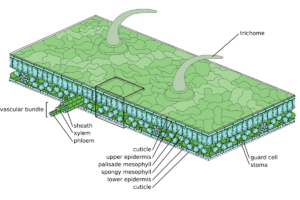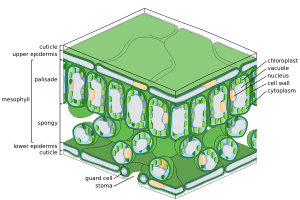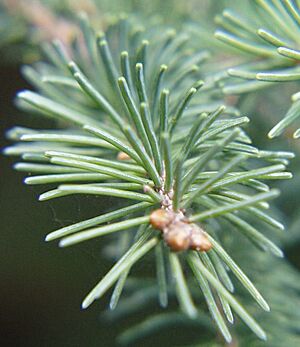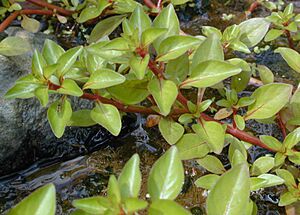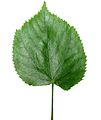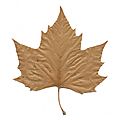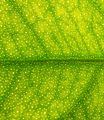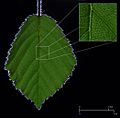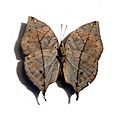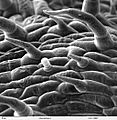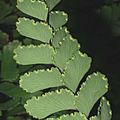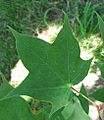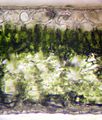Leaf facts for kids

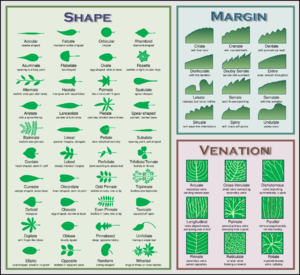
A leaf is a very important part of a plant that usually grows above the ground. Its main jobs are to make food for the plant through a process called photosynthesis and to exchange gases with the air. Leaves are often flat and thin. This shape helps them catch as much sunlight as possible. The sunlight then reaches tiny parts inside the leaf cells called chloroplasts, where food is made.
Most leaves have tiny openings called stomata. These stomata can open and close. They control how much carbon dioxide (which plants need), oxygen (which plants release), and water vapour (water in gas form) goes in and out of the leaf. This exchange happens with the air around the plant, which is called the atmosphere.
Plants that keep their leaves all year long are called evergreens. Think of pine trees! Other plants, like many trees and bushes, are deciduous. This means they shed their leaves, usually in autumn. Before they fall off, the leaves often change into beautiful colours like red, orange, and yellow. New leaves will then grow back in the spring.
Leaves come in many amazing shapes and sizes. The largest single leaf ever found belongs to a giant arum plant. This plant lives in the wet, marshy parts of the tropical rain forests of Borneo. One of its leaves can be as wide as ten feet (about 3 meters) and cover an area of over 30 square feet (about 2.8 square meters)!
Contents
What are the Main Parts of a Leaf?
A leaf is like a small factory, made up of different parts that work together. These parts are organized into special layers and structures. The main parts of a leaf are:
- The epidermis, which is the outer skin of the leaf.
- The mesophyll, which is the inner part where most of the food-making happens.
- The veins, which are like tiny roads that carry water and food.
The Epidermis: The Leaf's Skin
The epidermis is the very outer layer of cells that covers both the top and bottom surfaces of a leaf. It acts like a protective skin, separating the plant's inner cells from the outside world.
The epidermis has tiny pores called stomata. Each stoma is surrounded by special cells called guard cells. These guard cells contain chloroplasts. There are also other cells nearby called subsidiary cells, which do not have chloroplasts. The guard cells control the opening and closing of the stomata. This control is super important! It regulates how gases and water vapour move between the air outside and the inside of the leaf. This helps the plant do photosynthesis without losing too much water and drying out.
The Mesophyll: Where Food is Made
Most of the inside of the leaf, between the top and bottom epidermis layers, is filled with a tissue called the mesophyll. This name means "middle leaf" in Greek. This tissue is the main place where photosynthesis happens. During photosynthesis, plants use sunlight, water, and carbon dioxide to make sugars. These sugars are the plant's food!
In many plants, the mesophyll has two main layers:
- An upper palisade layer: This layer is made of tightly packed, tall cells. It's usually one or two cells thick. These cells are packed with many chloroplasts, which are the tiny factories that make food. The cells are slightly separated, which helps them absorb a lot of carbon dioxide. Leaves that get a lot of sun often have a thicker palisade layer than leaves that grow in the shade.
- A lower spongy layer: Below the palisade layer is the spongy layer. The cells here are more rounded and not as tightly packed. There are large air spaces between these cells. These cells have fewer chloroplasts than the palisade layer. The stomata on the leaf's surface open into these air spaces, allowing gases to move freely.
Leaves are usually green because of a pigment called chlorophyll found in the chloroplasts. Plants that don't have chlorophyll cannot make their own food through photosynthesis.
Veins: The Leaf's Transport System

The 'veins' in a leaf are like a dense network of tiny pipes. They contain two types of tubes:
- Xylem: These tubes bring water from the roots to the leaf, which is essential for photosynthesis.
- Phloem: These tubes carry the sugars (food) made during photosynthesis from the leaf to other parts of the plant.
The pattern formed by these veins is called 'venation'. In flowering plants, the venation pattern is different depending on the plant group. For example, in plants like grasses (monocotyledons), the veins are usually parallel to each other. But in broad-leaved plants (dicotyledons), the veins form a branching, interconnected network.
Hairs: Tiny Protectors on Leaves
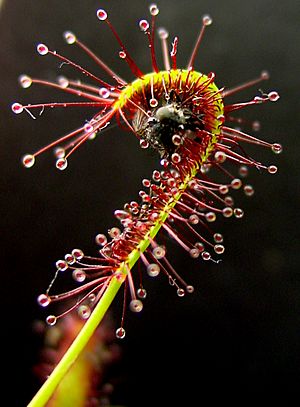
Many leaves are covered with tiny hairs called trichomes. These hairs come in many different shapes and have various jobs. Some trichomes are sharp and act like prickles to protect the plant. Others might be scaly. Some even secrete substances like oil. For example, Carnivorous plants have special trichomes that release digestive liquids to catch and eat insects!
Leaf Shapes and Arrangements
Leaves can look very different from one plant to another. Plants that are closely related often have similar types of leaves because they share a common ancestor. You can learn more about different leaf shapes and patterns at Wikibooks.
Basic Types of Leaves
Different groups of plants have distinct leaf types:
- Lycophytes have very small, simple leaves called microphylls.
- Ferns have large, often divided leaves called fronds.
- Conifers (like pine trees) usually have needle-shaped, awl-shaped, or scale-shaped leaves.
- Angiosperm (flowering plant) leaves typically have a flat blade, a stalk (petiole), and small leaf-like parts at the base (stipules).
- Sheath leaves are common in most grasses, where the base of the leaf wraps around the stem.
- Some plants have very specialized leaves, like the pitcher-shaped leaves of Nepenthes carnivorous plants.
How Leaves are Arranged on the Stem
The way leaves are placed on a stem is called phyllotaxis. Here are some common arrangements:
- Alternate: Leaves grow one by one, alternating sides along the stem.
- Opposite: Two leaves grow directly across from each other at the same point on the stem.
- Whorled: Three or more leaves grow in a circle around the stem at the same point.
Leaves often form a spiral pattern around the stem. The angle between successive leaves is often very regular and follows numbers from the Fibonacci sequence. This special arrangement helps each leaf get the best possible amount of sunlight.
Simple vs. Compound Leaves
Leaves can be described by how their main flat part (the blade or lamina) is divided:
- A simple leaf has a single, undivided blade. Even if the leaf has lobes (like an oak leaf), the cuts between the lobes do not reach the main vein.
- A compound leaf has a blade that is fully divided into smaller separate parts called leaflets. Each leaflet looks like a small leaf on its own. To tell if it's a compound leaf, look for where the leaf stalk (petiole) attaches to the main stem. Compound leaves are common in some plant families, like the Fabaceae (pea family). The central stem of a compound leaf is called a rachis.
Petioles: Leaf Stalks
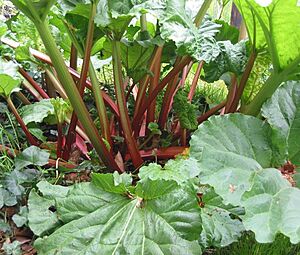
Many leaves have a stalk that connects the leaf blade to the main stem. This stalk is called a petiole. However, some leaves are sessile, meaning they don't have a petiole; their blade attaches directly to the stem. Sometimes, the leaf blade might even wrap around the stem, making it look like the stem is growing through the leaf!
In some Acacia trees, like the Koa Tree (Acacia koa), the petioles become wide and flat and act like leaf blades themselves. These are called phyllodes. Sometimes, you might still see small, normal leaves at the very tip of these phyllodes.
Stipules: Small Leaf-like Parts
A stipule is a small, leaf-like part that grows at the base of the petiole on many dicotyledon leaves. Stipules can either fall off as the leaf grows or stay attached.
Amazing Leaf Adaptations
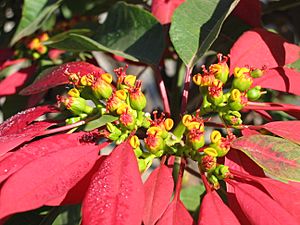
Over a long time, through evolution, many plants have developed leaves that are specially adapted to do other jobs besides just photosynthesis. These adaptations help the plant survive and thrive in its environment.
Here are some cool examples of leaf adaptations:
- Thorns: Some leaves have turned into sharp thorns to protect the plant from animals that might want to eat it.
- Tendrils: Some leaves have become thin, curling vines or tendrils that help the plant climb up other plants or structures, like in pea plants.
- Storage Leaves: In plants like the onion, some leaves are thick and store energy for the plant. Many succulent plants (like cacti) store water in their thick, fleshy leaves.
- Water Catchers: Some plants, called epiphytes, grow on other plants instead of in the ground. Their leaves are shaped to catch rainwater.
- Insect Traps: Carnivorous plants have amazing adapted leaves that act as traps to catch and digest prey like insects.
- Reduced Leaves: Leaves that are sliced or very thin can reduce how much wind resistance the plant experiences.
- Hairy Leaves: In dry places, leaves covered in hairs can trap humidity, helping the plant save water.
- Waxy Leaves: A waxy coating on the leaf surface also helps reduce water loss.
- Big Leaves: Large leaves provide a big area to catch sunlight. They can also create shade for the plant, which helps keep it cool and reduces water loss.
- Translucent Windows: Some plants have leaves that are mostly buried in the soil or are opaque, but they have clear "windows" that let light into the parts of the leaf that are underground.
- Chemical Defenses: Some leaves produce aromatic oils, poisons, or pheromones from special glands. These chemicals can stop animals from eating the plant (e.g., eucalyptus).
- Mineral Defenses: Leaves can also contain hard, crystalline minerals like silica (in grasses) or raphides (in Araceae) that make them tough to chew for herbivores.
- Attracting Pollinators: The colourful Petals of flowers are actually modified leaves that attract insects and other animals to help with pollination.
- False Flowers: Some plants, like Spurges, have bright bracts (special leaves) that look like petals. These bracts attract pollinators when the true flowers are very small.
Images for kids
-
Vein skeleton of a leaf. Veins contain lignin that make them harder to degrade for microorganisms.
-
Near the ground these Eucalyptus saplings have juvenile dorsiventral foliage from the previous year, but this season their newly sprouting foliage is isobilateral, like the mature foliage on the adult trees above
-
A leaf shed in autumn
-
Citrus leaves with translucent glands
-
Whorled leaf pattern of the American tiger lily
-
The venation within the bract of a lime tree
-
Micrograph of a leaf skeleton
-
The veins of a bramble leaf
-
Some insects, like Kallima inachus, mimic leaves.
-
The scale-shaped leaves of the Norfolk Island Pine.
-
Common mullein (Verbascum thapsus) leaves are covered in dense, stellate trichomes.
-
Scanning electron microscope image of trichomes on the lower surface of a Coleus blumei (coleus) leaf
-
Silky aster (Symphyotrichum sericeum) leaves are sericeous.
See also
 In Spanish: Hoja para niños
In Spanish: Hoja para niños



